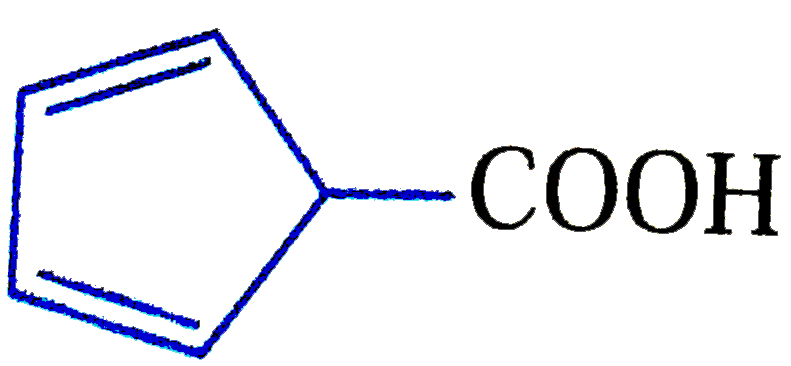The number of carboxylic acids which are more acidic than acetic acid amongst the following are:
(i)HCOOH
(ii)CICH2COOH
(iii)Cl3CCOOH
(iv)FCH2COOH
(v)CI3CCOOH
(vi)CH3CH2CHCICOOH
(vii)CH3CHCICH2COOH
To determine the number of carboxylic acids that are more acidic than acetic acid (CH₃COOH) among the given options, we need to analyze the effect of substituents on the acidity of each compound. The acidity of carboxylic acids is influenced by the stability of the carboxylate ion formed after deprotonation. Electron-withdrawing groups (EWGs) increase acidity by stabilizing the negative charge on the carboxylate ion, while electron-donating groups (EDGs) decrease acidity.
1. Identify Acetic Acid as the Reference:
- Acetic acid (CH₃COOH) will be our reference point for acidity.
2. Analyze Each Compound:
- (i) HCOOH (Formic Acid):
- Formic acid is more acidic than acetic acid because it has no electron-donating methyl group. The absence of the CH₃ group means that the negative charge on the carboxylate ion is more stable.
- Conclusion: More acidic than acetic acid.
- (ii) CICH₂COOH (Chloroacetic Acid):
- The chlorine atom is an electron-withdrawing group (EWG) due to its -I effect. This increases the acidity compared to acetic acid.
- Conclusion: More acidic than acetic acid.
- (iii) Cl₃CCOOH (Trichloroacetic Acid):
- With three chlorine atoms, this compound has a strong -I effect, greatly stabilizing the carboxylate ion and making it much more acidic than acetic acid.
- Conclusion: More acidic than acetic acid.
- (iv) FCH₂COOH (Fluoroacetic Acid):
- Fluorine is a stronger electron-withdrawing group than chlorine. Therefore, fluoroacetic acid is also more acidic than acetic acid.
- Conclusion: More acidic than acetic acid.
- (v) CI₃CCOOH (Trichloroacetic Acid):
- This is the same as option (iii) and is also very acidic due to the presence of three chlorine atoms.
- Conclusion: More acidic than acetic acid.
- (vi) CH₃CH₂CHClCOOH (Chloro-Butanoic Acid):
- The chlorine atom is on the adjacent carbon, which exerts a -I effect, increasing acidity compared to acetic acid.
- Conclusion: More acidic than acetic acid.
- (vii) CH₃CHClCH₂COOH (Chloro-Butanoic Acid):
- Similar to option (vi), the chlorine atom still exerts a -I effect, but it is less effective than in (vi) due to its position. However, it is still more acidic than acetic acid.
- Conclusion: More acidic than acetic acid.
3. Count the Acids More Acidic than Acetic Acid:
- All seven compounds analyzed (i to vii) are more acidic than acetic acid.
Final Answer:
The number of carboxylic acids which are more acidic than acetic acid is 7.
---
- Acetic acid (CH₃COOH) will be our reference point for acidity.
- (i) HCOOH (Formic Acid):
- Formic acid is more acidic than acetic acid because it has no electron-donating methyl group. The absence of the CH₃ group means that the negative charge on the carboxylate ion is more stable.
- Conclusion: More acidic than acetic acid.
- The chlorine atom is an electron-withdrawing group (EWG) due to its -I effect. This increases the acidity compared to acetic acid.
- Conclusion: More acidic than acetic acid.
- With three chlorine atoms, this compound has a strong -I effect, greatly stabilizing the carboxylate ion and making it much more acidic than acetic acid.
- Conclusion: More acidic than acetic acid.
- Fluorine is a stronger electron-withdrawing group than chlorine. Therefore, fluoroacetic acid is also more acidic than acetic acid.
- Conclusion: More acidic than acetic acid.
- This is the same as option (iii) and is also very acidic due to the presence of three chlorine atoms.
- Conclusion: More acidic than acetic acid.
- The chlorine atom is on the adjacent carbon, which exerts a -I effect, increasing acidity compared to acetic acid.
- Conclusion: More acidic than acetic acid.
- Similar to option (vi), the chlorine atom still exerts a -I effect, but it is less effective than in (vi) due to its position. However, it is still more acidic than acetic acid.
- Conclusion: More acidic than acetic acid.
- All seven compounds analyzed (i to vii) are more acidic than acetic acid.
The number of carboxylic acids which are more acidic than acetic acid is 7.
Topper's Solved these Questions
- ALDEHYDES ,KETONES AND CARBOXYLIC ACIDSBOOK - MODERN PUBLICATIONCHAPTER - ALDEHYDES ,KETONES AND CARBOXYLIC ACIDSEXERCISE - UNIT PRACTICE TEST
13 Videos
- ALDEHYDES ,KETONES AND CARBOXYLIC ACIDSBOOK - MODERN PUBLICATIONCHAPTER - ALDEHYDES ,KETONES AND CARBOXYLIC ACIDSEXERCISE - COMPETITION FILE ( OBJECTIVE TYPE QUESTIONS - MULTIPLE CHOICE QUESTIONS (MCQ) ( D. MULTIPLE CHOICE QUESTIONS )
17 Videos
- ALCOHOLS, PHENOLS AND ETHERSBOOK - MODERN PUBLICATIONCHAPTER - ALCOHOLS, PHENOLS AND ETHERSEXERCISE - UNIT PRACTICE TEST (FOR BOARD EXAMINATION)
12 Videos
- BIOMOLECULESBOOK - MODERN PUBLICATIONCHAPTER - BIOMOLECULESEXERCISE - UNIT PRACTICE TEST FOR BOARD EXAMINATION
13 Videos
Similar Questions
Arrange the following in the increasing order of acidic strength :
(i) ClCH2COOH
(ii) CH2ClCH2COOH
(iii ) FCH2COOH
(iv) CH3COOH
View SolutionWrite the IUPAC names of the following :
(i)CH3CH=CHCOOH (ii)CH3CH2CH2COOH (iii)C6H5CH2COOH (iv)(CH3)3CCOOH (v)CH3CH2COCH2COOH(vi)(CH3)3CCH2COOH <br> (vii)CH3−C∣OHH−CH2COOH
View Solution
Knowledge Check
The correct order of acidity in given compounds
(i) FCH2COOH
(ii) CICH2COOH
(iii) NO2CH2COOH
(iv) CH3COOH.Ai>ii>iii>ivBiv>iii>ii>iCiii>iv>i>iiDiii>i>ii>iv.Find the correct acidic strength order:
(i) HC≡C−COOH (ii)H2C=CH−COOH
_CHM_E01_002_Q01.png) (iv)CH3−CH2−COOHA(i)>(ii)>(iv)>(iii)B(i)>(ii)>(iii)>(iv)C(iii)>(ii)>(i)>(iv)D(iii)>(i)>(iv)>(ii)
(iv)CH3−CH2−COOHA(i)>(ii)>(iv)>(iii)B(i)>(ii)>(iii)>(iv)C(iii)>(ii)>(i)>(iv)D(iii)>(i)>(iv)>(ii)Arrange the following carboxylic acids in the decreasing order of their reactivities:
(i)CH3COOH(ii)ClCH2COOH(iii)Cl2CHCOOH
(iv)Cl3CCOOHA(ii)>(iv)>(i)>(iii)B(ii)>(i)>(iii)>(iv)C(iv)>(iii)>(ii)>(i)D(i)>(ii)>(iii)>(iv)
Arrange the following in the order of increasing acidic strength :
(I)CH3CHFCOOH
(ii)CH3CH2COOH
(iii)CH3CF2COOH
View SolutionExplain the following :
(a) In gaseous phase, the acidic characters of the following are :
(i) CH3CH2COOH(I)>CH3COOH(II)
(ii) ClCH2COOH(III)>FCH2COOH(IV)
(iii) Me3C−OH(V)>MeCH2CH2CH2OH(VI).
(b) Account for the following differences in the acidic characters of the following :
(i) (I)Me3C−CH2−COOH>(II)Me3SICH2COOH
(ii) (III)H2C=CHCH2COOH>(IV)CH3CH2COOH
(iii) (V)HC≡C−CH2COOH(pKa3.22)>(VI)H2C=CHCH2COOH(pKa=4.35)
(iv) CH3−C∣∣O−CH2−COOH>
(v) (IX)N≡C−CH2COOH>(X)CH3COCH2−COOH
(vi) (XI)PhCh2COOH>(XII)CH2=CHCH2COOH.
View SolutionThe number of compounds among the following which are more reactive than acetic acid towards decarboxylation by soda -lime is/are

C(CH3)3COOH (IV)

(V) O2N−CH2COOH (VI) Cl3−COOH (VII)

View SolutionMe3CCH2COOHis more acidic than Me3SiCH2COOH.
View SolutionWhich is the stronger acid in the following pair?
CH3−CH2−COOHandNC−CH2−COOH
View Solution
